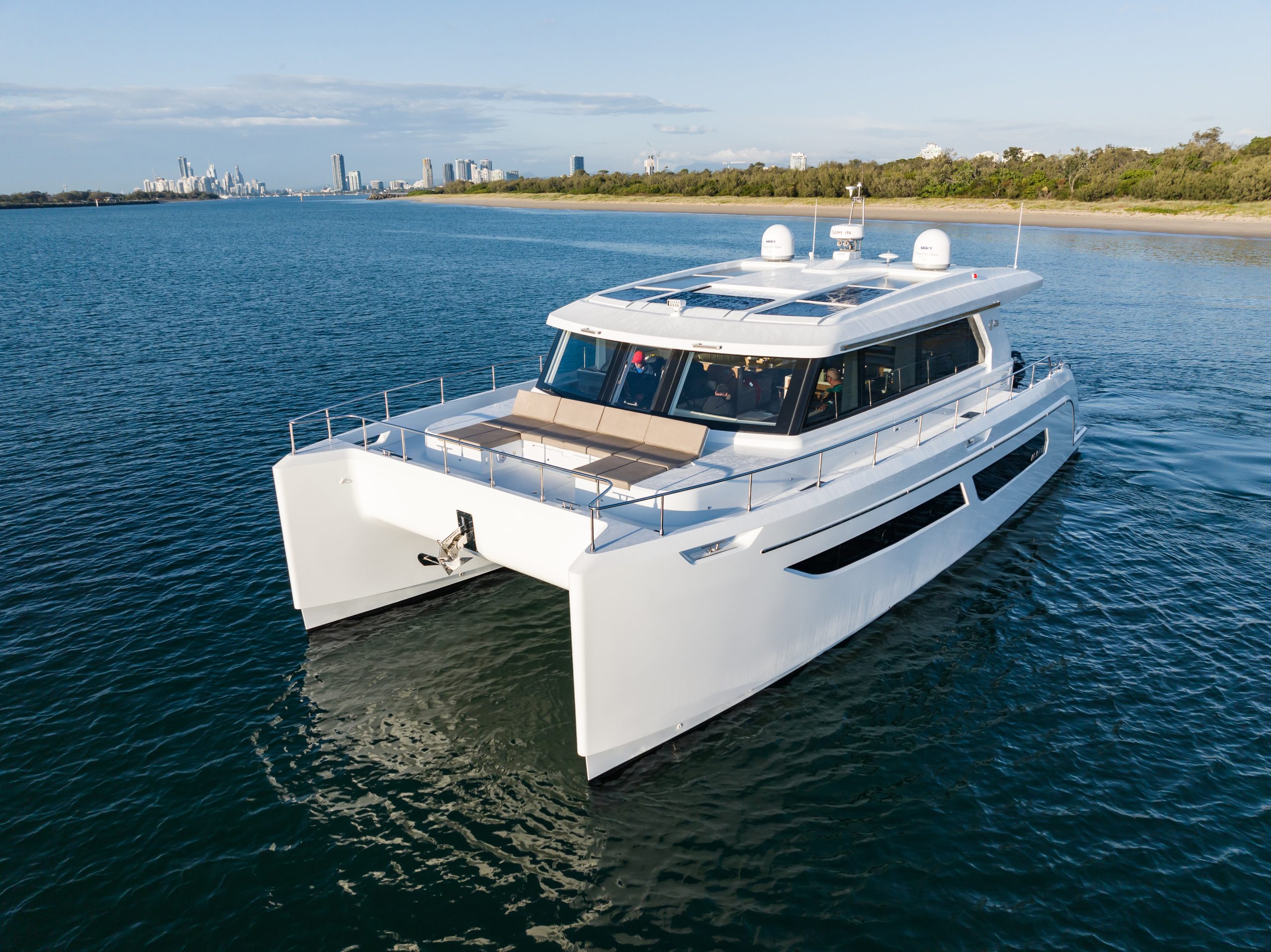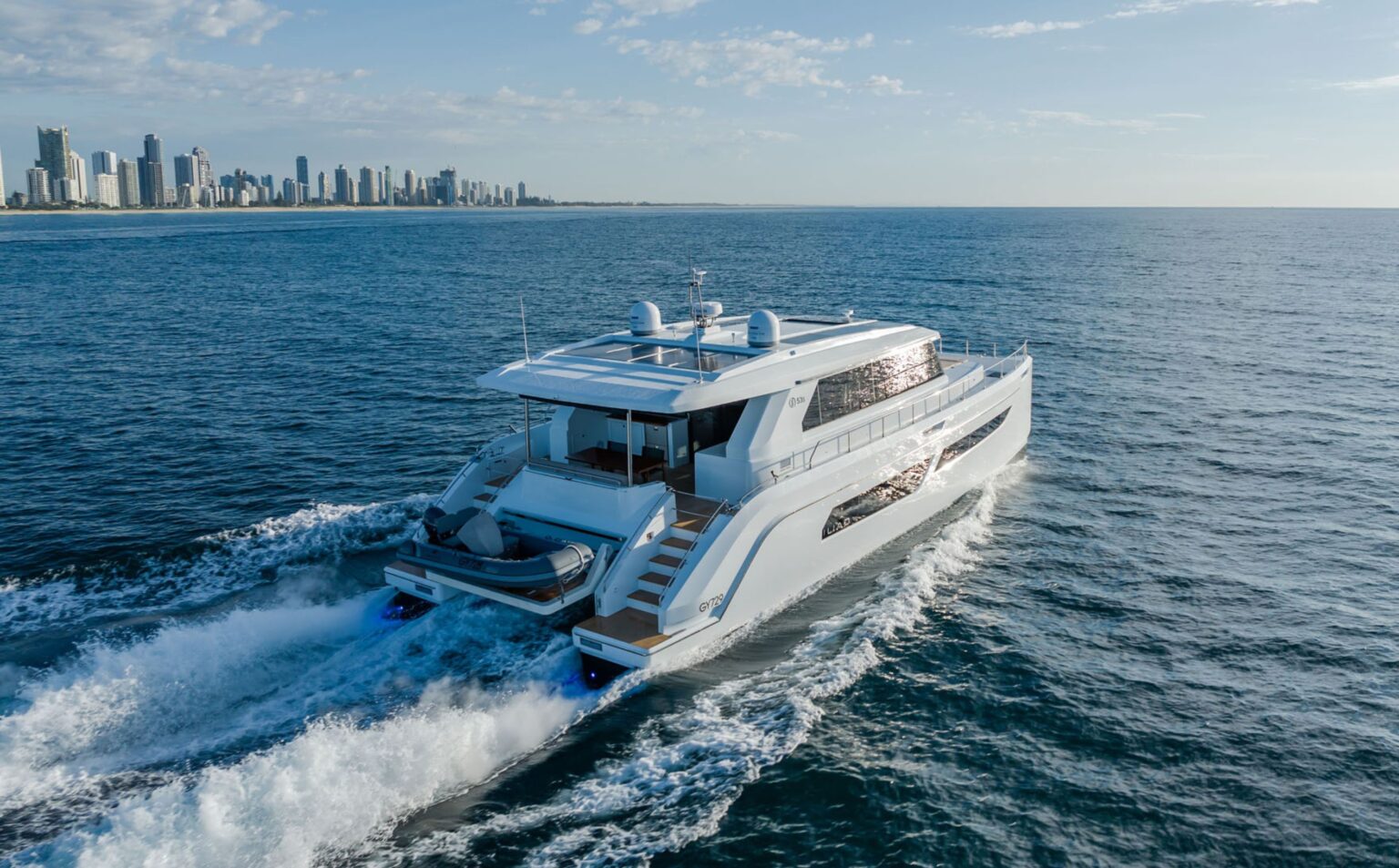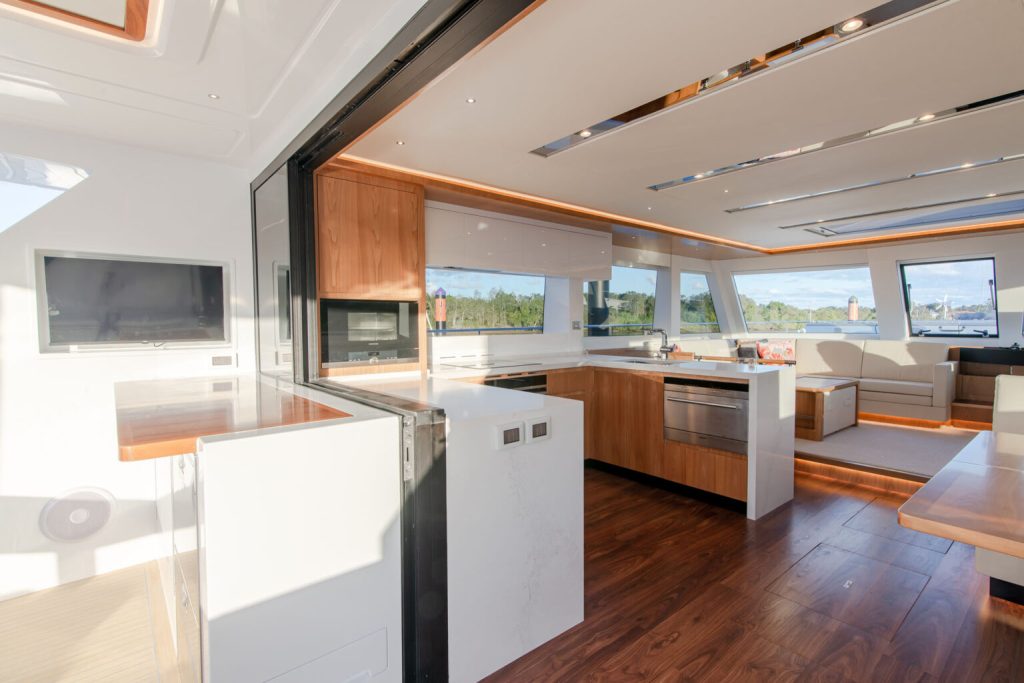
ILIAD 53S Review

ILIAD 53S

November 10, 2023

Kevin Green

Boating New Zealand
Power catamarans are the fastest-growing sector in the boating market, for some very good reasons. Reasons like frugality, comfort – and for adventure cats like this ILIAD 53 Sport – long-range capabilities. Lifestyle is the other main driver of demand for these vessels. Their inherent features, such as shallow draft, and in this case beach-ability, makes them ideal explorer boats.

Let’s Explore
Explorer-style yachts continue to grow in popularity as people seek to escape the crowds and further embrace technologies that liberate them from onshore services. For motor yachts, fuel efficiency is a key feature, and this is where sedan catamarans with their low-drag hulls are very attractive.
Wanting something special, Mark Elkington formed a consortium a couple of years ago that included ILIAD’s now General Manager Michael ‘Nod’ Crook and his team, yacht designer Riccardo Bulgarelli, and a leading South Asia shipyard. The result was ILIAD Catamarans. The ILIAD range includes the 53S, 52F and 53E, the ILIAD 62 and the (upcoming) 75 models. These semi-displacement catamarans couple double-digit cruising speeds with long range. The key to these capabilities is a wide array of engine choices, all shaft-driven, and tailored to a customer’s needs. Shaft drives, protected by mini keels, minimise grounding damage should any dramas occur.
Sleek Sedan
This first Sport Sedan from the brand was heavily visited during the 2023 Sanctuary Cove boat show. This 53 Sport is an all-weather boat, with a fully-covered aft cockpit enclosed in roll-up clears. There was plenty to see, as I discovered. The semi-custom build and exceptionally high level of detailed finish is a key market differentiator, explained ILIAD GM Michael ‘Nod’ Crook. “The can-do attitude of the Chinese yard has been so important for us, especially when configuring the custom parts of these boats,” he said.
Offering fully-optioned base boats, rather than swathes of add-ons afterwards, has been another strong selling point. For example, on this 53 Sport the only major add-ons were the watermaker, upgraded air-conditioning and lifting swim platform. Given this boat’s maiden voyage will be a threemonth sojourn in remote tropical North Australia, with a final home in Western Australia, good air-conditioning and self-sufficiency are prerequisites.
Compared to the range’s flybridge models, the ILIAD 53S has much less windage and greater stability, so it looks much sleeker, which appealed to its new owner Marc. The aft section of the main deck should appeal to buyers like Marc coming from the narrower beam of a Riviera or similar motor yacht – the ILIAD 53S has the vast, unimpeded relaxation space that only a catamaran can offer.
A wet bar, electric barbecue, ice maker and a table for eight means the aft deck is an alfresco extension of the saloon, especially since the galley is just inside. The entire area is shaded by the flybridge extension, furnished with an electric sunroof, and flows seamlessly into the saloon via sturdy sliding doors.
Voluminous Saloon
Inside the open-plan saloon, the galley to port has a dinette opposite and the lounge on the forward port quarter. To starboard is the steering console and twin electric Besenzoni helm seats – a bench seat is standard. The front part of the saloon is elevated, to ensure good vision.
The owner chose Garmin smarts, with two large screen MFDs, plus autopilot. In addition, the console sports Yanmar’s engine screen and throttles, plus the standard bow thruster control (for a single tunnel thruster on the port hull). Optional vertical interceptor tabs were fitted, to help with trim and fuel efficiency under load. The other key system is the main power board, which is near the galley. Switches (12V and 24V) were neatly laid out, along with all essential controls, air-conditioner and Cummins generator management, and the Sea-Fire system for the engine room.
The saloon appears vast, thanks in part to the open-plan layout and low-slung cabinetry finished in elm, a mediumcoloured wood that nicely matches the immaculate two-pack white-painted bulkheads and cupboards. Underfoot carpet is laid over spotted gum wood. Vertical sides give lots of volume and natural light, while a man-sized opening front window provides airflow at anchor and foredeck access for an agile adult (me!).
A U-shaped galley with a household-sized fridge was chosen over the optional enclosed return bench version: “We want the whole family to enjoy this area and to use the rear part for serving the cockpit,” explained Marc. Appliances include a Fisher & Paykel electric hob with separate microwave and a dishwasher.
An array of drawer fridge-freezers ensure the perishables remain cold – other white goods include a washing machine in the guests’ hull. Spacious Himacs composite worktops and a deep stainless sink, large cupboards overhead and under the worktops – ideal for expedition victualling – plus watertight storage in the nacelle, which is great for maintaining the temperature of your wine, are galley features. There weren’t any fiddles, but they are an option.
The level of detailing and finish quality is remarkable, illustrated by the large dining table with integrated soft seating around its base to accommodate more guests. The joinery is hand-finished in most places with rounded ends, curved cocktail tabletops and immaculate stitching in the UltraLeather couches.
Private Suite
Gently sloping steps just in front of the dinette-galley lead down into the starboard hull and the owner’s suite. Closed off by a sliding door, the entire hull is dedicated to the owner, with a large island bed in the stern where the motion is kindest at sea, ablutions in the bow, and the vanity/desk midships. Cleverly, a walk-in wardrobe aft (which could be optioned as ablutions) acts as sound buffer from the adjoining engine room. The athwartships queen bed faces large rectangular portlights and sumptuous elm panelling and carpet on the floor gives a cosy feel throughout. There’s subtle attention to detail with quality metal door/cupboard fittings and a luxuriously padded couch complemented by strategically-placed handrails.

In the bathroom, the tall topsides ensure plenty of volume while opening portlights provide airflow that’s essential for the tropics, reducing reliance on the air-conditioning unit. There’s comfortable teak underfoot with practical (if rather glaring) easy-wipe gelcoat finish elsewhere. A quality freshwater electric head nicely finishes off the area.
Accommodation in the port hull is clearly designed for the family, specifically the large number of young members in the owner’s entourage. In the stern there are two large single berths (queen bed optional) with memory foam mattresses surrounding bookshelves and tasteful mood-lighting. The forward berth is a standard double with another single bunk slightly elevated beside it (under the nacelle). The adjoining bathrooms – one for each cabin – are fully-featured just like the owner’s. They include spacious shower units. Cabins and bathrooms benefit from natural airflow and light from skylights and portlights.
Beachable Hull
Usable deck space is important for tropical voyaging, and it is generous on the ILIAD 53S with its large fore and aft cockpits. Wide side-decks with deep bulwarks and tall safety rails guide you to the bows. There you’ll find twin sunbeds (in quality Sunbrella fabric with elevating backrests) with lockers between them to house the essential anchoring gear and all the cushions.
Two vast bow lockers with ladders provide yet more storage, or they can be optioned as crew berths. The rode for the 40kg stainless Lewmar anchor runs under the nacelle, safely away from bare feet. It is controlled by a Quick 2,000W vertical windlass. Ideally, a second roller should be fitted (it is available on new builds), but good points included double sets of oversize cleats and large fairleads that also quickly shed water.
Moving back aft, each hull has moulded steps down to the water with a hydraulic swim platform between them that can house a tender. Cockpit hatches either side access a pair of Yanmar 440hp engines – Yanmar or Volvo 440hp are standard. Upgrades include Yanmar 480hp or Cummins 550hp, but any engine brand is possible. The hull protects the shafts with moulded skegs when the boat is beached and allowed to dry out.
Looking inside the engine room revealed a spacious and well-organised space with electrics and AGM starting batteries elevated above the Yanmar 440s. The exhausts now run through the transom to reduce fumes (as opposed to exiting on the sides in earlier models). Only leading industry standard components are used, such as a Victron 5,000W inverter/charger and Racor filters with a Sea-Fire automatic fire suppression system. Service access to the oilways and belts is also adequate, as it is to the quadrant and steering linkages. Other key systems here include the 13.5kW Cummins Onan generator and hot water system.
House electrics are by Victron, arranged in a special locker in the nacelle, with another locker of lithium house batteries nearby. Excellent levels of renewable energy are provided by 3,200W worth of solar panels on the roof – the solar array was outputting about 50 amps during my visit. Engines and ship’s systems are all housed in a sturdily built CE A category hull with mini keels to allow a grounding (or a hull scrub on a tidal beach). The yard was visited by independent European CE inspectors at key stages of the build. Vinylester is used above and below the waterline, with monolithic or solid glass around the keel line and other key areas. Elsewhere, vacuum-infused PVC closed-cell sandwich is used. Ample bridgedeck clearance – I estimated it at nearly a metre – minimises wave impact on the nacelle and watertight bulkheads are used throughout the vessel.
Gold Coast Sea Trial
The sheltered waters of the Gold Coast, hidden behind barrier islands, are ideal catamaran country, if somewhat lacking in swells. It was our lot for the day on the ILIAD 53 Sport. Nudging our way from the marina immediately after the Sanctuary Cove boat show was tricky, requiring full use of the twin engines and a gentle nudge by the bow thruster here and there to move us sideways, then backwards. Skipper Jason Norton then eased the electronic throttles forward to power us down the meandering Coomera River.
Most catamarans respond to judicious use of the throttles – in a fore and aft movement to spin the hulls, but with the windage on such tall hulls, a thruster is welcome for the amateur skipper. Surrounded by riverside mansions and premium cars such as Bentleys, the ILIAD 53S looked very much at home.
At the estuary, on the busy Gold Coast Broadwater, I took the helm. Leaning against the bolster seat with the steering wheel at waist height, the views were superb in virtually every direction. Steering response was instantaneous thanks to the electric-hydraulic steering system and twin rudders set wide apart. Pushing down the electronic throttles brought a faint roar from the twin 440hp Yanmars before planing speed was reached. Prior to that we’d been in trawler mode at 8 knots, which is the long-range cruise speed. It affords a range of 1,750 miles. Increasing speed – to outrun a tropical storm for example – reduces this range significantly, but the speed (maximum 21 knots on our test) is there if you need it. Even at full throttle noise levels were low enough (about 60db) to allow easy conversation.
Crossing the wakes of the many large powerboats on this busy waterway didn’t upset the Iliad 53 S – no groans, creaks or rattles from anywhere as we broached a few tall wakes. The comfortable helm seat supported me well. The open-plan layout provides clear views aft – always essential in narrow waterways – and useful when I demonstrated slow speed handling to Marc by spinning his yacht on its axis and going astern in a predictable manner.
As we cruised back to the marina, I found myself envying the family starting out on their 3,000-mile odyssey across the tropical North Australia, a journey this ILIAD 53 Sport is ideally suited to. BNZ










